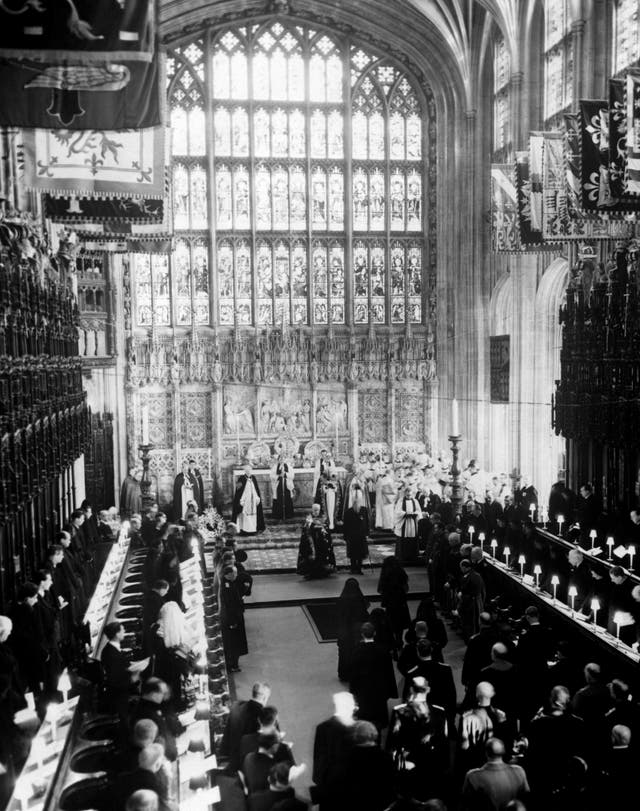
The Duke of Edinburgh’s coffin descended into the Royal Vault during his funeral service, lowered by an electric motor.
It was a moment never seen before on television, with Joe Little, managing editor of Majesty magazine, describing it as “unique in British royal history”.
Usually, the movement of the coffin into the vault beneath the floor of the Quire of St George’s Chapel would take place in private.

But for Philip’s funeral, the coffin began to move down incredibly slowly, as the Dean of Windsor read the Commendation and the Garter King of Arms proclaimed the lengthy list of the duke’s regal styles and titles.
Part of the lowering was filmed by the BBC cameras, which moved away at times to focus on other elements, including the Garter King of Arms, a piper’s lament, and the Actions Stations naval battle cry by buglers.
After the coffin descended, the open rectangular space leading to the vault could be seen in the floor of the Quire.
The Duke of Sussex, after bowing his head in front of the altar, was seen to glance down briefly towards the open vault as he made his way out of the chapel at the end of the service.

At George VI’s funeral in 1952, the king’s coffin was lowered into the vault but the proceedings were not televised so the working operation of the motor has not been broadcast before.
Photographs of the occasion taken from a distance show the new Queen Elizabeth II stood in front of the space in the floor after the coffin had descended.
She sprinkled earth into the vault and was stood with the widowed Queen Mother, her sister Princess Margaret and the king’s sister Princess Mary.

Philip personally selected the regalia – the medals and decorations conferred on him by the UK and Commonwealth countries – together with his Royal Air Force wings and Field Marshal’s baton, which were pre-positioned on nine cushions on the altar in the chapel.
The Royal Vault at Windsor was created between 1804 and 1810 for George III, who died in 1820 and is one of three kings buried there.
Also interred in the vault are George IV and William IV.
Others buried there include George III’s wife Queen Charlotte and their daughter Princess Amelia, George IV’s daughter Princess Charlotte and Queen Victoria’s father the Duke of Kent.
Princess Margaret, who died in 2002, was cremated and her ashes were initially placed in the Royal Vault, before being moved to the George VI memorial chapel with her parents’ coffins when the Queen Mother died just weeks later.
It is not the duke’s final resting place.
When the Queen dies, he will be transferred to the church’s King George VI memorial chapel to lie alongside his devoted wife of 73 years.
The tiny chapel houses the remains of George VI, the Queen Mother and Princess Margaret.
George VI was interred into the Royal Vault first and moved to the memorial chapel annex when it was built 17 years later.


Why are you making commenting on The National only available to subscribers?
We know there are thousands of National readers who want to debate, argue and go back and forth in the comments section of our stories. We’ve got the most informed readers in Scotland, asking each other the big questions about the future of our country.
Unfortunately, though, these important debates are being spoiled by a vocal minority of trolls who aren’t really interested in the issues, try to derail the conversations, register under fake names, and post vile abuse.
So that’s why we’ve decided to make the ability to comment only available to our paying subscribers. That way, all the trolls who post abuse on our website will have to pay if they want to join the debate – and risk a permanent ban from the account that they subscribe with.
The conversation will go back to what it should be about – people who care passionately about the issues, but disagree constructively on what we should do about them. Let’s get that debate started!
Callum Baird, Editor of The National
Comments: Our rules
We want our comments to be a lively and valuable part of our community - a place where readers can debate and engage with the most important local issues. The ability to comment on our stories is a privilege, not a right, however, and that privilege may be withdrawn if it is abused or misused.
Please report any comments that break our rules.
Read the rules here